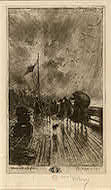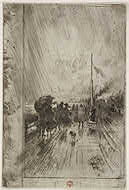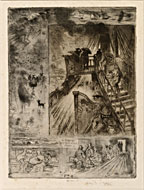
Introduction: Impressions of City and Sea
The etchings of Félix-Hilaire Buhot are among the most original and enchanting prints made in France during the late nineteenth century. Born in 1847 in the small town of Valognes in Normandy, Buhot was orphaned at the age of seven. He nurtured his early love for art by poring over rare illustrated books and manuscripts in his hometown’s library. In 1865 he moved to Paris, where he studied painting and drawing at the École des Beaux-Arts. He learned to etch in about 1873 and quickly established himself as a successful printmaker. Buhot lived and worked most of his life in Paris, with frequent visits back to northern France and extended trips to England. He suffered from prolonged bouts of depression, which deepened over time. By 1892 he had ceased making prints, and six years later he died at the age of fifty-one.
Buhot’s prints were made at a time of renewed interest in original printmaking (especially etching), which was rapidly becoming more popular than reproductive engraving. His etchings were singled out for praise as early as 1874 by the preeminent critic Philippe Burty, who admired the artist’s belles épreuves (beautiful proofs)— a term Burty promoted to denote rare, superbly inked impressions printed by the artist himself. By the 1880s Buhot had become one of the best-known and most collected printmakers of his day. Buhot’s renown extended well beyond his own country, and he also enjoyed critical acclaim and strong support for his prints in the United states.
In 1888 the New York print dealer Frederick Keppel (1845-1912) gave Buhot his first one-man exhibition, which was quite successful. In addition to Keppel, Buhot became friends with two prominent late nineteenth-century American collectors who amassed large numbers of the artist’s prints: Samuel P. Avery (1822-1904) of New York collected over 300 prints and George A. Lucas (1824-1909) of Baltimore owned some 200 prints. Beginning in 1911, another large collection was formed by Albert H. Wiggin (1868-1951) of Boston, who bought over 150 impressions. Today, these collections can be found in, respectively, the New York Public Library, the Baltimore Museum of Art, and the Boston Public Library.
Today, the National Gallery of Art’s collection of more than one hundred prints and drawings by Buhot is unsurpassed in the fine quality and variety of the artist’s most iconic etchings. The museum’s first Buhot prints were donated in 1943 by Lessing J. Rosenwald, an early founder of the Gallery’s print department. Further gifts were made by a variety of donors, and in the 1990s important donations were made by Helena Gunnarsson, who in acquiring outstanding impressions of important subjects has become one of the foremost collectors of the artist’s prints. Finally, the collectors Jacob and Ruth Kainen have also assembled a group of noteworthy and rare prints by Buhot, which either have been given or promised to the Gallery. This exhibition of more than sixty prints and several drawings is selected from these private collections as well as from that of the National Gallery of Art.




